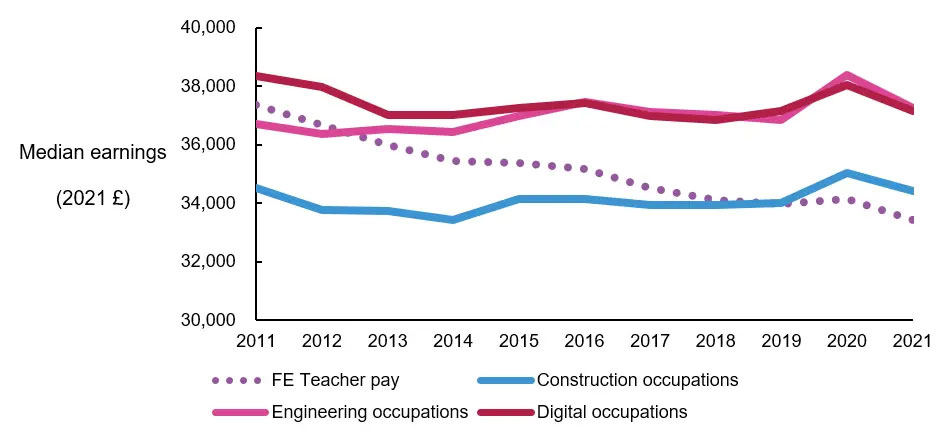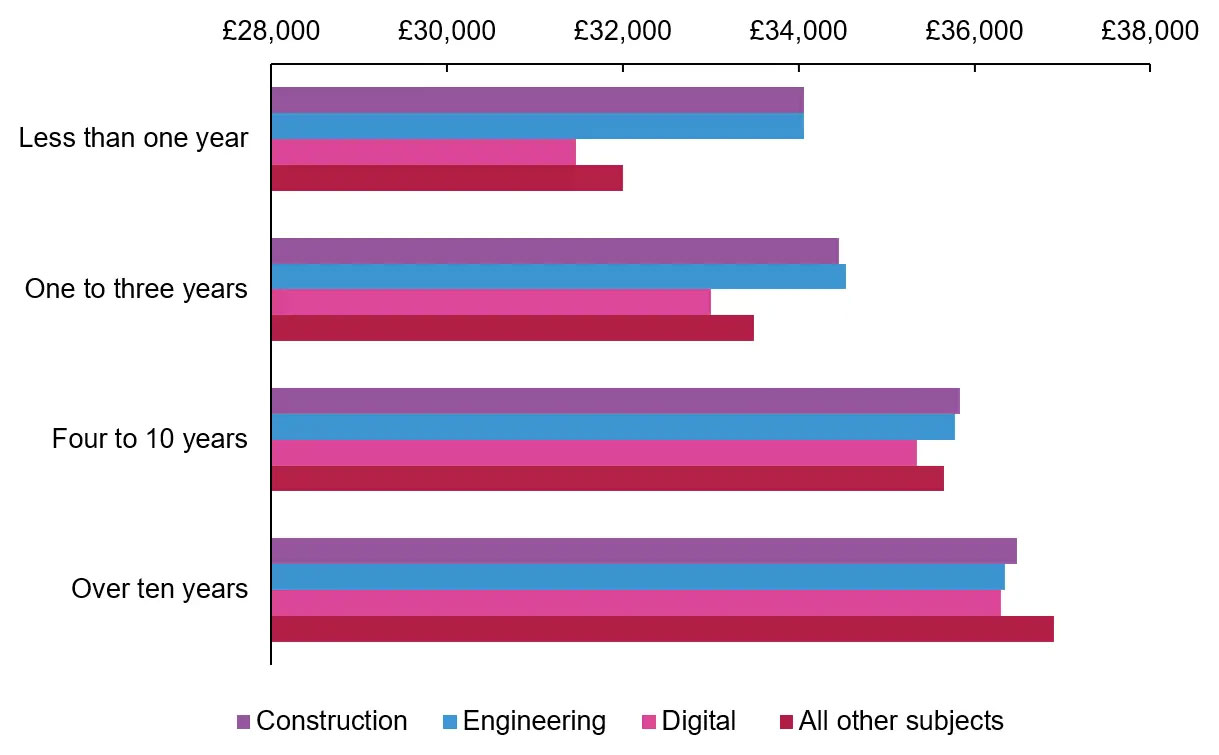FE colleges need better tools to compete for their teacher workforce
Tuesday 24 September 2024

This blog post was first published in FE News on Wednesday 18 September.
The further education (FE) sector is crucial to England’s education system, providing training programmes essential for addressing skills gaps and helping students transition into skilled jobs. Yet the sector has been facing a critical under-supply of teaching staff in recent years, driven by poor recruitment and higher leaving rates than for primary and secondary school teachers.
A new report, commissioned by the Gatsby Charitable Foundation, explores the landscape of Construction, Engineering and Digital FE teacher supply, showing that the interplay of pay and working conditions contributes to teacher shortages in these fields.
Pay disparities are a barrier to FE colleges recruiting from industry
Government funding for the FE sector has fallen significantly in real terms over the last decade, leading to falling teacher pay. This has widened pay gaps with industry for Construction, Engineering and Digital teachers since 2011 – making it harder for FE colleges to attract teaching staff with relevant industry experience.
Median earnings for FE teachers and in relevant Construction, Engineering and Digital occupations in industry, 2011 - 2021

Note: Comparison occupations in our focus subjects reflect the most realistic alternative occupations in industry. See the full report for more detail. Earnings for part-time workers adjusted to full-time equivalent (FTE).
Source: NFER analysis of Annual Survey of Hours and Earnings, Department for Education and FE Workforce Data Collection data for 2011 to 2021.
Uncompetitive pay also contributes to a negative feedback loop whereby colleges use higher starting salaries to entice new recruits into FE, particularly for Construction and Engineering. This can then lead to poor future pay progression compared to other subjects that can negatively impact retention.
Median earnings for FE teachers by subject and number of years of experience in their teaching role

Note: Earnings for FE teachers working part time are adjusted to FTE earnings.
Source: NFER analysis of FE Workforce Data Collection data (for 2021/22)
Those who are drawn specifically to a teaching career can also likely find a better pay offer in other educational settings. Our analysis showed that, in 2021, pay for FE teachers in the focus subjects was 23 per cent lower than in other education occupations such as primary or secondary teachers, or lecturers in higher education. The recent Government announcement of a 5.5 per cent pay rise for state-sector primary and secondary teachers, with no equivalent rise for FE colleges, will exacerbate this inequality. Furthermore, the research shows that FE teachers feel that their growing administrative and pastoral responsibilities have meant the demands of the role are increasingly incommensurate with the pay. This can further negatively impact retention.
Policy must focus on breaking negative feedback loops
Realistically, FE teaching is unlikely to ever offer a similar level of financial rewards as in, for example, a private-sector tech firm or freelance plumbing business. It does not have to – the inherent reward of teaching and lifestyle benefits compared to some sectors can be sufficient to attract skilled workers from industry. However, our research shows that FE college pay and working conditions are increasingly undermining this inherent attractiveness.
The Government must ensure its commitment to improving teacher supply in England extends to the FE college workforce, given the crucial role it plays in the education system. The Education Secretary has promised a ‘reset’ in the relationship between Government and the school teacher workforce, to ‘make clear the valuable role [teachers] play in the Government’s agenda for change’. This renewed relationship must also include FE teachers, with funding and a plan to close pay gaps between FE and other settings, as well as further work to address concerns about FE teacher workload.
A solid first step to address the disparity in pay between FE colleges and schools could be to ask the School Teachers’ Review Body to produce a stand-alone report on FE college teacher pay.
The approaches taken by FE colleges to support their staff are also critical for retention. Interviewees overwhelmingly identified their staff team and management as the key motivation for them to stay in their college. Additional support for new starters – such as mentoring, shadowing opportunities or a reduced teaching load – can help individuals moving from industry into teaching.
Offering more flexible working options to FE teachers can also be attractive, for example, for on-site construction or engineering workers. Models for how this can work in practice already exist. Previous work by the Gatsby Charitable Foundation has shown, for example, that having Industry Associates work flexibly between industry and FE colleges can benefit colleges by bringing in the latest industry knowledge and processes while also demanding less of a financial commitment from industry employees to work in FE.
Policy decisions also need to be guided by evidence. The FE Workforce Data Collection is a crucial new source of insights into workforce dynamics in the FE sector, and will continue to help inform policymaking as the representativeness and coverage of the data improves and evolves over time. In the future, linking it with other data sources (such as school workforce data) could provide an even richer understanding of movement between FE and other sectors.
For many, teaching is a calling. As one interviewee said: ‘At the end of the day, we’re here to bring on the next generation of engineers… I don’t know anyone who has been through our staff doors in the last 10 years who doesn’t enjoy that’. But, as this research shows, more needs to be done so pay and working conditions do not obstruct this mission.
